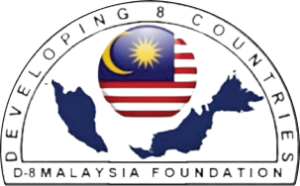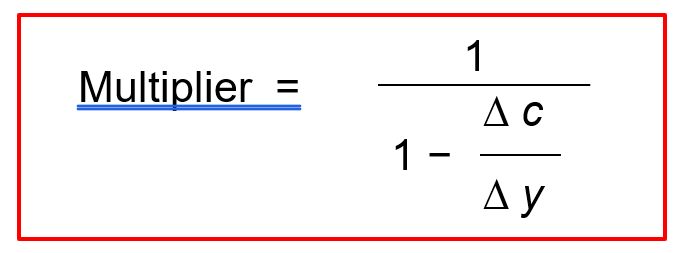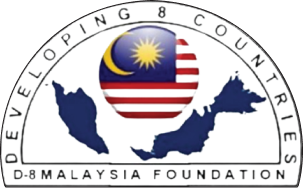
Boosting GDP in D-8 Countries Through the Islamic Gift Economy
To demonstrate how the IGE can contribute to GDP growth in D-8 countries, we can utilize economic models and equations, particularly the Expenditure Multiplier Effect, Quantity Theory of Money, as well as other relevant economic frameworks. This analysis will illustrate how implementing IGE principles can enhance economic activity and ultimately lead to GDP growth.
Economic Models and Equations
1. Expenditure Multiplier Effect
The Expenditure Multiplier measures the total change in GDP resulting from an initial change in aggregate spending. It is calculated using the formula:

where (Δy) / (Δc) represents the change in consumption (Δc) resulting from the change in income (Δy)
Application of IGE to the Expenditure Multiplier
- Initial Increase in Spending: In the context of IGE, autonomous spending can come from community contributions, such as donations, waqf funds, or zakat. For instance, if a community decides to invest $1 million into local businesses through a cooperative model, this initial injection into the economy serves as the starting point for the multiplier effect.
- Impact on Consumption: As this $1 million is spent on goods and services, it generates income for local businesses and workers. If we assume a of 0.6 (meaning households spend 50% of any additional income), the subsequent rounds of spending can be calculated as follows:
- First Round: $1,000,000 spent leads to $600,000 in new consumption.
- Second Round: The $600,000 results in $360,000 in new consumption.
- Third Round: The $360,000 leads to $216,000 in new consumption.
- And so forth…
- Calculating Total Impact: The total increase in GDP can be calculated by summing these rounds of spending until the impact diminishes significantly.
Example Calculation
Using the expenditure multiplier formula:

- This means that every dollar spent will result in a total impact of $2.50 on GDP.
- If we start with an initial investment of $1 million:
Total Change in GDP = Initial Investment × Multiplier = $1,000,000 × 2.5 = $2,500,000
Thus, an initial investment of $1 million could potentially lead to a total increase in GDP of $2.5 million through the multiplier effect.
2. Quantity Theory of Money
The Quantity Theory of Money is primarily represented by the equation MV = PT. It is used to explain how the amount of money in an economy (money supply) relates to the overall price levels and economic activity. Here are the key forms of the equation:
M = Money supply
V = Velocity of money (the rate at which money circulates)
P = Price level
T = Transaction volume
Application of IGE to the Quantity Theory of Money
- Increasing Money Supply (M): The Islamic Gift Economy encourages community-based financial contributions, such as through waqf (charitable endowments) and sadaqah (voluntary charity). These contributions can increase the money supply available for local investments and businesses, enhancing economic activity.
- Enhancing Velocity of Money (V): By promoting cooperative business practices and mutual support among community members, the velocity of money can increase. When individuals engage in frequent transactions within their communities, the money circulates more rapidly, contributing to higher economic activity.
- Increasing Transaction Volume (T): The IGE encourages individuals to participate in local economies through gifting and sharing resources. This increases the overall transaction volume as more people buy and sell goods and services.
3. Economic Growth Models
Solow Growth Model
The Solow Growth Model emphasizes that economic growth is driven by capital accumulation, labour force growth, and technological progress. In the context of IGE:
- Capital Accumulation: Capital can be accumulated more effectively through community investments funded by waqf or cooperative ventures. This model allows for reinvestment into local businesses, leading to job creation and productivity increases.
- Labor Force Growth: By promoting entrepreneurship through community support systems, IGE can lead to the establishment of new businesses, thereby increasing employment opportunities.
- Technological Progress: The collaborative nature of IGE encourages knowledge sharing and innovation among community members, fostering technological advancements that contribute to growth.
4. Redistribution Models
The principles of wealth redistribution in IGE can be modelled using various frameworks:
- Wealth Redistribution Mechanisms: Instruments like zakat and waqf ensure that wealth circulates from richer segments to poorer ones. This redistribution reduces inequality and enhances purchasing power among lower-income groups, stimulating demand for goods and services.
- Impact on Gini Coefficient: Studies have shown that wealth redistribution mechanisms in Islamic economies lead to a lower Gini coefficient over time compared to capitalist models. A lower Gini coefficient indicates reduced income inequality, which is crucial for sustainable economic growth as it allows for broader economic participation.
